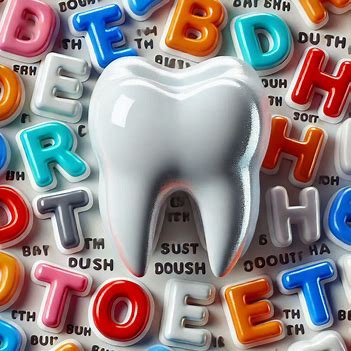Teeth are hard, calcified structures found in the mouths of humans and many animals. They are essential for breaking down food, which makes digestion easier, and play a role in speech, facial aesthetics, and overall health.

1. Structure of Teeth
Teeth have several layers, each with its specific function:
- Enamel: The hard, outer surface of the tooth. Enamel is the hardest substance in the human body and protects the inner layers of the tooth.
- Dentin: The layer beneath the enamel. Dentin is softer than enamel but still provides structure and support to the tooth. It also contains tiny tubules that can transmit sensations (e.g., pain or temperature).
- Pulp: The soft tissue at the center of the tooth that contains nerves, blood vessels, and connective tissue. The pulp is responsible for the nourishment and sensation of the tooth.
- Cementum: A bone-like material that covers the root of the tooth and helps anchor it to the jawbone.
- Root: The part of the tooth that is embedded in the jawbone. The root holds the tooth in place and contains the pulp within its canals.
2. Types of Teeth
Humans have different types of teeth, each adapted to a specific function in the process of eating:
- Incisors: The four front teeth on the top and bottom of the mouth. These teeth are flat and sharp and are used for cutting food.
- Canines (Cuspids): Located next to the incisors, canines are pointed and used for tearing food.
- Premolars: Located behind the canines, these teeth have two or more cusps and are used for grinding and tearing food.
- Molars: The large, flat teeth at the back of the mouth. Molars have several cusps and are primarily used for grinding and crushing food.
- Wisdom Teeth: These are the third set of molars, typically emerging in late adolescence or early adulthood. Not everyone develops wisdom teeth, and in some cases, they are removed due to complications.
3. Functions of Teeth
Teeth are essential for various functions:
- Chewing and Digestion: Teeth break down food into smaller pieces, making it easier for enzymes in the digestive system to process the food.
- Speech: Teeth, along with the tongue, help produce certain sounds, particularly “s,” “f,” and “th” sounds.
- Aesthetic Function: Teeth are an important part of facial appearance. A healthy smile can contribute to self-esteem and confidence.
- Protection: Teeth help protect the mouth and the rest of the body by serving as a barrier against harmful bacteria.
4. Dental Development
Teeth begin developing early in life:
- Baby Teeth (Primary Teeth): These are the first set of teeth, and they begin to emerge in infants at around 6 months of age. Children typically have 20 baby teeth by the age of 3.
- Permanent Teeth: These replace baby teeth and begin to emerge around age 6. By the age of 12 or 13, most children have lost all their baby teeth, and permanent teeth have fully emerged. Adults typically have 32 permanent teeth, including the wisdom teeth.
- Wisdom Teeth Eruption: Wisdom teeth generally emerge between the ages of 17 and 25. In some cases, wisdom teeth may need to be removed due to lack of space or other complications.
5. Common Dental Problems
Various issues can affect the health and function of teeth:
- Cavities (Dental Caries): Caused by bacteria that produce acids that break down tooth enamel. Cavities can lead to pain, infection, or tooth loss if untreated.
- Gum Disease (Periodontal Disease): Infections of the gums and tissues around the teeth, often caused by plaque buildup. It can lead to gum recession, tooth mobility, and even tooth loss.
- Tooth Sensitivity: Caused by the exposure of the dentin layer (due to gum recession or enamel wear), leading to discomfort when eating hot, cold, or acidic foods.
- Tooth Decay: The gradual destruction of the tooth’s enamel and underlying layers due to plaque and bacteria.
- Malocclusion: Misalignment of teeth, often resulting in problems with bite and appearance. This may require orthodontic treatment.
6. Tooth Care and Oral Hygiene
Proper care of your teeth is essential for maintaining oral health:
- Brushing: Brush your teeth at least twice a day using fluoride toothpaste. This helps remove plaque, prevent cavities, and reduce the risk of gum disease.
- Flossing: Flossing once a day helps remove food particles and plaque between the teeth and along the gumline, where a toothbrush can’t reach.
- Regular Dental Check-ups: Visit a dentist at least once a year for a professional cleaning and check-up to detect any issues early.
- Diet: A healthy diet rich in vitamins and minerals, particularly calcium and vitamin D, is important for strong teeth. Avoid sugary foods and beverages, which contribute to cavities.
- Mouthwash: Using mouthwash can help kill bacteria, freshen your breath, and add an extra layer of protection for your teeth.
- Avoid Smoking: Smoking can contribute to gum disease, tooth decay, and tooth discoloration.
7. Cosmetic Dentistry
Some people seek cosmetic dentistry to improve the appearance of their teeth:
- Teeth Whitening: Professional treatments or over-the-counter products can help lighten the color of teeth that have been stained or discolored.
- Veneers: Thin shells of porcelain or composite resin placed on the front of teeth to improve their appearance (e.g., correcting chips, cracks, or discoloration).
- Braces or Clear Aligners: Used to straighten misaligned teeth, improving both function and appearance.
8. Tooth Loss and Replacement
When teeth are lost due to decay, injury, or disease, they can be replaced with:
- Dental Implants: Artificial tooth roots that are surgically placed in the jawbone and topped with a crown to replace missing teeth.
- Bridges: A dental bridge is used to replace one or more missing teeth by anchoring the replacement teeth to adjacent healthy teeth.
- Dentures: Removable appliances that replace missing teeth, are often used for people who have lost several or all of their teeth.
